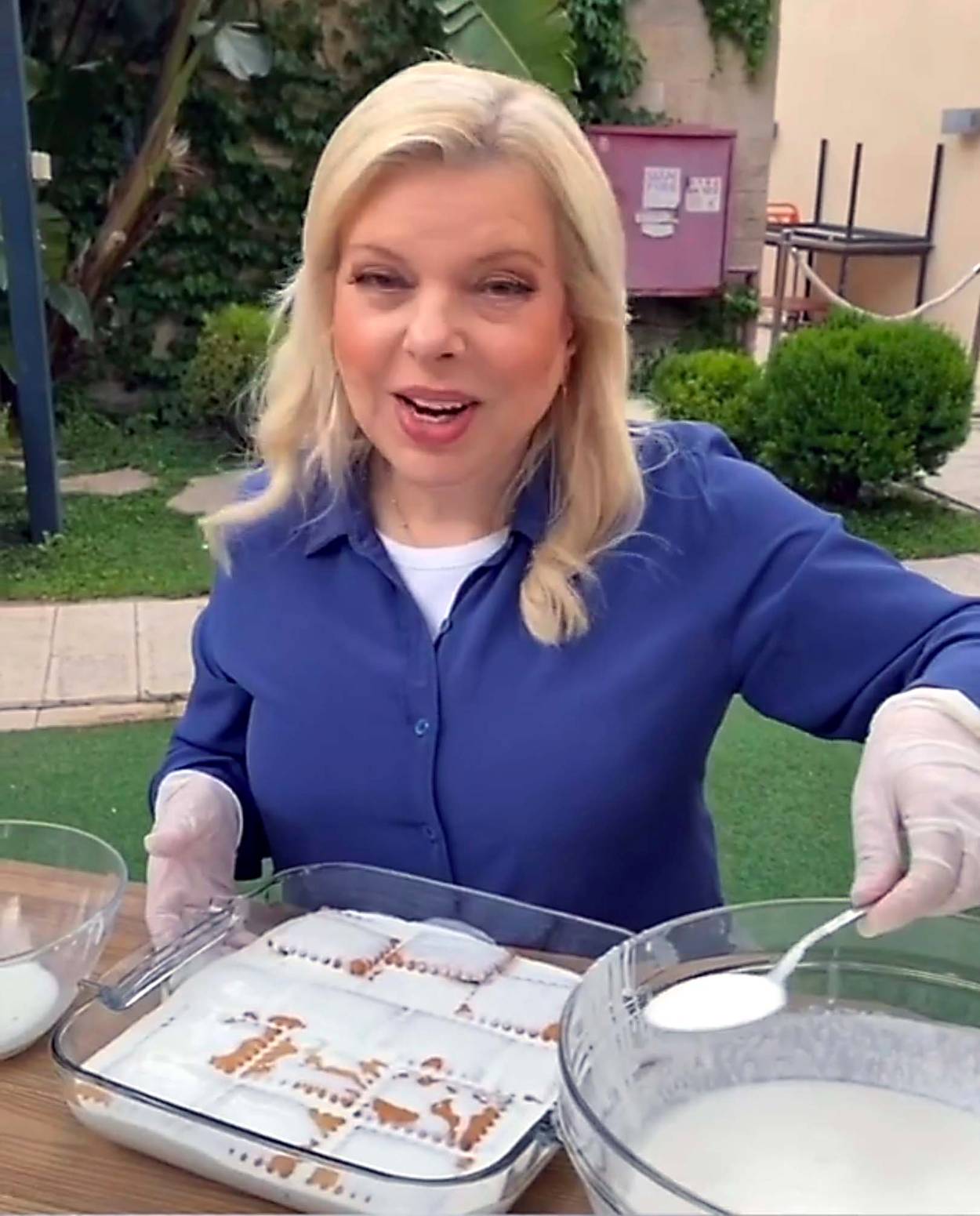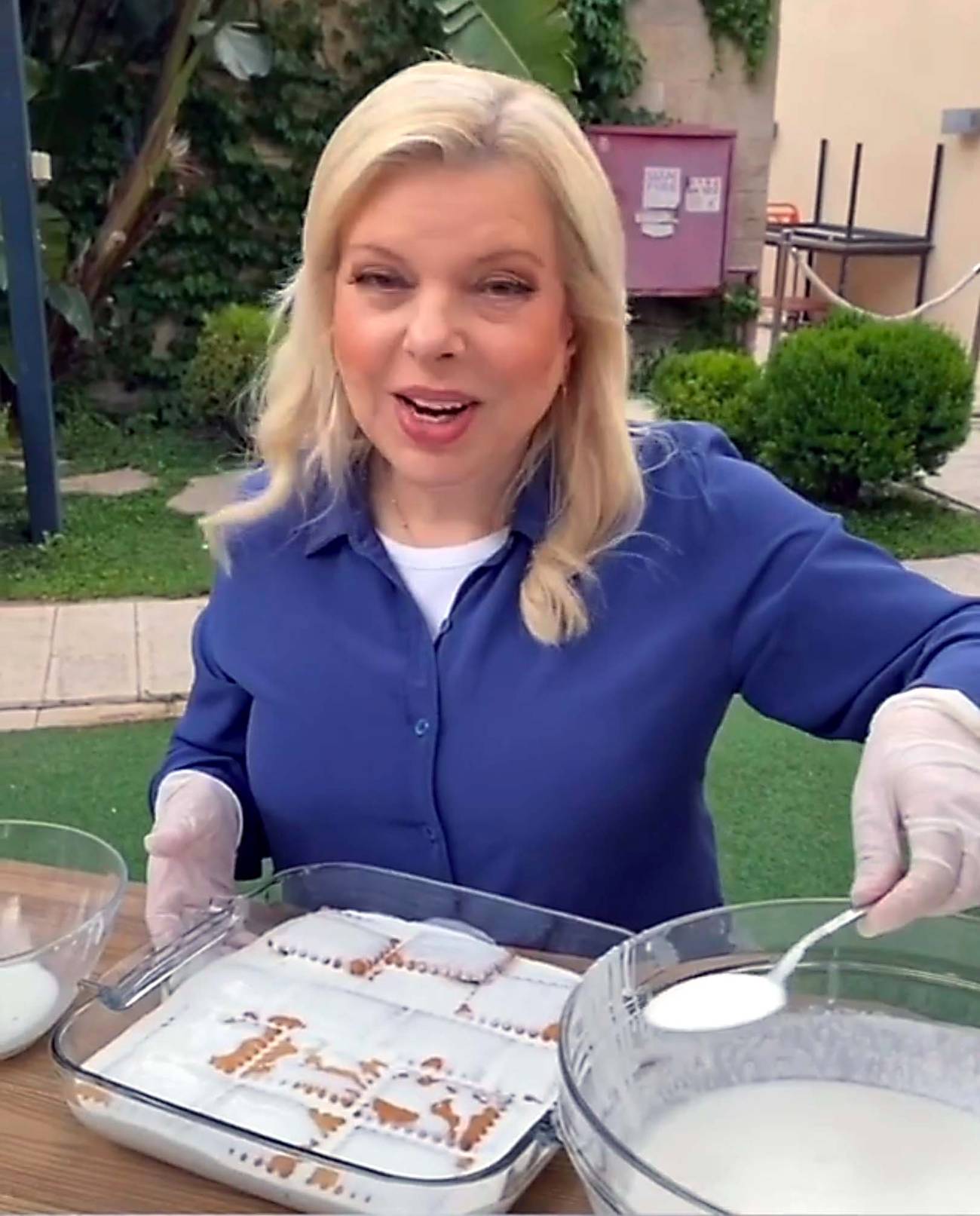The Cake That Unites—and Divides—Israelis
Everyone loves no-bake biscuit cake. But how, exactly, to make it is up for debate.




Right before Yom Ha’Atzmaut, Israeli Independence Day, a video appeared on Prime Minister Benjamin Netanyahu’s Instagram channel that caused a terrible storm across the country. The video’s merits were debated on social media; memes were created in response; angry responses blew up the Israeli internet.
That video was about a cake.
Netanyahu’s wife, Sara, had posted the video, demonstrating, step by step, how to make her family’s “traditional” biscuit cake—one of Israel’s most iconic and ubiquitous desserts. (The “biscuit” here is not the buttery, flaky roll that Americans devour for breakfast, but the flat, usually square, graham cracker that in Israel is called biskvit.) Standing on a lawn outside the family home, Sara Netanyahu soaked biscuits in milk, mixed an Israeli type of runny cream cheese with sugar, and then, in a moment no one saw coming, spilled whipping cream into the bowl, without whipping. That’s when the storm began.
According to Ha-Makom , an independent Israeli news website, the faulty recipe was in fact a publicity stunt, meant to distract the public from the prime minister’s legal trouble and to “clean up” the web from negative posts about his wife. Whatever the intention was, the amount of public outcry and the outpouring of social media suggestions on how to make the “right” biscuit cake proved that the humble dessert is a nationwide obsession. But how did it come to be? Beyond the memes and the current momentum it’s having, the story of the layered cake is the story of its cornerstone, the biscuit, but also of local pride, unlikely consensus, and Jewish ingenuity.
The biscuit cake is a combination of softened graham crackers, a filler—a mix of whipped cream and cream cheese, in many cases—and chocolate coating. Usually, the cake takes on a square shape, but occasionally it’s a triangular pyramid, with the biscuits serving as “walls” for a sweet house filled with creamy goodness. The biscuit itself is a cult Israeli product; as with many cases of a popular brand name becoming the placeholder in the language (for years, a smartphone in Israel was called pelephone, after the first company that introduced it to the local market) the Israeli digestive biscuit is often called peti-ber (a Hebrew twist on the French pioneering pastry le petit beurre, directly translated as “small butter”). That’s because for decades, since 1942, the Israeli answer to the popular French product has been made by Osem, a leading foods manufacturer. The megabrand, the legend goes, introduced Peti Ber in the country after seeing le petit beurre being manufactured and packaged by the French, Germans, and Brits at a European food trade show.
In the U.S, where every dessert imaginable can be found, the biscuit cake is not that popular. While a recipe for such a cake can be found on blogs here and there, it’s not an item you’ll find widely discussed or starring on restaurant menus. (Tiramisu is at least in the same extended family, but its base is ladyfingers and its superpower is coffee.) The cake does exist in France, where the petit beurre was born, and in Britain, where digestive tea biscuits are a staple, but it isn’t exactly a trend. In Israel, however, pastry chefs and food bloggers wouldn’t imagine their portfolio without it, and in 2018 Walla Food, a popular website, called it a “timeless hit.
Such a cult favorite could only be born from a marriage of convenience and mass marketing. In the early days of Israel, such marketing was more than possible, since only a couple of brands and a handful of cookbooks ruled the market. Some say that a recipe for the biscuit cake was first distributed by Osem itself, and in 1975, a hugely popular cookbook, Yeladim Mevashlim (Children Cooking), solidified the biscuit cake’s status as a household recipe. Behind it is Ruth Sirkis, the legendary food writer who’s responsible for some of the most memorable recipes in the Israeli canon. “Those kids who would make the cake with their parents back then are the heart of the population now,” Sirkis told me. “And they now make it with their kids, as the cake passes from generation to generation.”
According to Sirkis, the biscuit cake is a crowd pleaser thanks to its multigenerational fame: “Everyone knows it and loves it, and if you’re hosting, you can’t go wrong with it.” Sirkis also points out that the Peti Ber biscuits made by Osem, and nowadays by other brands like Elite and Shufersal, are pareve, made without the French addition of butter and milk. Hence, it has an ever-broader culinary appeal for those who keep kosher. “It used to be made with instant vanilla pudding from a package,” Sirkis said, and that pudding could also be made without dairy.
Like many Jewish foods, the biscuit cake is both nostalgic and constantly reinvented. But in its case, the cake is also the peak of approachability, a democratic summit rare in Israel’s often-conflicted culinary landscape. “The Israeli food world had made a huge leap in the last 20 years, but before that, it used to be a culinary desert,” said Rotem Drob, a culinary content consultant. “So the biscuit cake is made with the most-available ingredients you can imagine—everyone could go to the corner store, from a city to a kibbutz, and purchase Osem’s Peti Ber, whipping cream or instant pudding, and simple chocolate.” From available ingredients, to nearly zero skills in the kitchen: Per Sirkis’ book, the cake is perfect for making with children, and, to be honest, could probably be made by a young child without parental supervision. “This is a foolproof cake that’s very suitable for the hot Israeli climate,” Drob said. “You don’t need to bake it, no need to worry: Will it rise? Will it fall? Is it baked through? No need to be dedicated to baking to make it successfully. The only two results when you make this cake can be “WOW!” or just “tasty.”
And it’s not only the simplicity and the common ingredients that make the biscuit cake such a favorite. It may very well be one of the few recipes that are totally Israeli—embraced by all, but unrelated to Ashkenazi or Mizrahi origins, unclaimed by any of the myriad ethnicities that constitute Israel’s population. It belongs to everyone’s childhood memory, to the 1970s and to the home cooks. “It’s totally homegrown,” said Drob. “It transcends ethnicity.”
Sara Netanyahu’s mishap, amid the turbulent times of COVID-19, may have brought a new wave of biscuit cake creations to social media, causing everyone to flaunt “their” best recipe. But it also reminded Israelis that, unlike the Netanyahus, the biscuit cake is something everyone agrees on.
Flora Tsapovsky is a San Francisco-based food and culture writer.